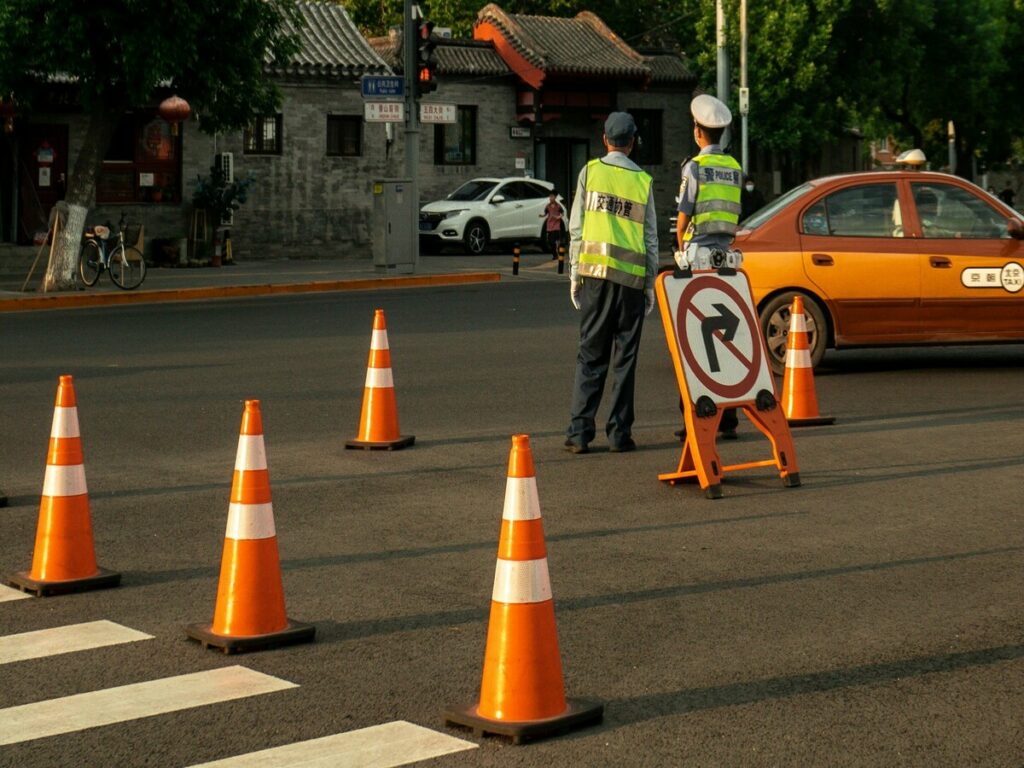
Rising raw material prices are reshaping the cost of everyday products, including cheap traffic cones. Supply chain disruptions have played a major role in this trend. Research shows that delays caused by the COVID-19 パンデミック created significant order backlogs and longer delivery times. These challenges have limited suppliers’ ability to meet growing demand, leading to higher costs. メーカー向け, this means increased expenses for materials like rubber and plastic. If you plan to buy traffic cones, you may notice these price changes. Even temporary solutions like traffic cones for sale are now more expensive due to these pressures.
Despite the rising material costs, OptSigns remains committed to delivering affordable solutions without compromising quality. Keep an eye out for promotions and discounts on トラフィックコーンをOptSigns to make sure you get the best value for your investment.
Key Drivers of Rising Raw Material Prices

Supply Chain Disruptions in the Global Traffic Cones Market
Supply chain disruptions have created significant challenges in the global traffic cones market. The COVID-19 pandemic caused delays in shipping and production, leading to shortages of essential materials like rubber and PVC. These disruptions increased costs for manufacturers, which directly impacts the price of traffic cones. Geopolitical tensions, など Russia-Ukraine conflict, have further strained supply chains. These tensions have limited the availability of raw materials and increased transportation costs. 結果として, you may notice higher prices for traffic cones, even for budget-friendly options.
Inflation and Energy Costs Affecting Traffic Cones
Inflation and rising energy costs have also contributed to the increasing cost of traffic cones. The production of PVC, a key material in traffic cones, requires significant energy input. 例えば, producing a 3-meter PVC pipe consumes 223.4 kWh of energy. Shipping traffic cones from overseas manufacturers, such as those in Taiwan, adds to the energy burden. Transporting 4,000 cones can consume 1.6 tons of bunker fuel, と同等 17,600 kWh of energy. These energy-intensive processes, combined with inflation, have driven up production costs. This increase has made it more expensive for manufacturers to produce and distribute traffic cones.
Increased Demand and Limited Supply in the Growth of Traffic Cones Market
The growth of the traffic cones market has been fueled by rising demand and limited supply. The market is projected to grow from $3.27 10億インチ 2024 に $4.15 10億 2032. This growth is driven by road construction, 交通渋滞, and enhanced safety measures. しかし, the supply of raw materials like polyvinyl and thermosets remains limited. Infrastructure projects worldwide have further increased the demand for traffic cones. With global infrastructure spending expected to exceed $9 兆単位 2025, the demand for traffic cones will continue to rise. This imbalance between demand and supply has led to higher prices in the global traffic cones market.
Geopolitical Issues Impacting Raw Material Availability
Geopolitical issues have a significant impact on the availability of raw materials in the traffic cones market. Conflicts and political instability disrupt supply chains, making it harder for manufacturers to source essential materials like rubber and PVC. 例えば, the Russia-Ukraine conflict has affected the global traffic cones market by limiting access to petroleum-based products. These materials are critical for producing traffic cones, and their scarcity drives up costs.
Trade restrictions and sanctions また、役割を果たします. Countries involved in geopolitical disputes often impose export bans or tariffs on raw materials. This limits the flow of goods across borders, creating shortages in the traffic cones market. You may notice that these restrictions lead to higher prices for even the most affordable traffic cones.
Natural disasters and regional tensions further complicate the situation. 例えば, hurricanes or floods in key manufacturing regions disrupt production and transportation. These events delay shipments and reduce the availability of raw materials in the global traffic cones market. 結果として, manufacturers face higher costs, which are often passed on to you as a consumer.
Geopolitical issues also increase transportation costs. Political instability in regions with major shipping routes can lead to delays and higher fuel prices. These factors add to the overall expense of producing and distributing traffic cones. The global traffic cones market must navigate these challenges to meet growing demand while keeping costs manageable.
Understanding how geopolitical factors affect the traffic cones market helps you make informed purchasing decisions. By staying aware of these issues, you can better anticipate price changes and plan accordingly.
How Rising Costs Impact the Production and Pricing of Cheap Traffic Cones

The Role of Plastic and Rubber in Traffic Cones
Plastic and rubber are essential materials in the production of cheap traffic cones. PVC, a type of plastic, provides durability and flexibility, while rubber ensures stability and grip. しかし, the rising demand for these materials in industries like automotive and construction has created supply shortages. This imbalance has increased the cost of production for traffic cones. Manufacturers face challenges in sourcing high-quality materials at affordable prices, which directly impacts the pricing of cheap safety cones in the traffic cones market. When you buy cheap traffic cones, you may notice higher prices due to these material-specific cost increases.
Energy-Intensive Manufacturing Processes for Traffic Cones
The production of traffic cones involves energy-intensive processes. 例えば, producing PVC requires significant energy, with chlorine production alone consuming 16.34 kwh. Ethylene synthesis adds another 5.56 kwh. Shipping traffic cones further increases energy use. Transporting 4,000 cones from Taiwan to Los Angeles consumes 17,600 kwh, equivalent to the annual energy use of an average American household. Rising energy prices have made these processes more expensive, increasing the overall cost of production. Compared to other industries, traffic cone manufacturing shares similar energy demands, from raw material extraction to shipping. These energy requirements highlight why the traffic cones market faces rising costs.
Transportation and Distribution Costs in the Traffic Cones Market
Transportation and distribution play a critical role in the traffic cones market. Shipping traffic cones from overseas manufacturers involves high fuel consumption. 例えば, transporting cheap safety cones across long distances requires bunker fuel, which has become more expensive due to global energy price hikes. These rising transportation costs add to the final price of cheap traffic cones. さらに, delays caused by geopolitical tensions and natural disasters further increase distribution expenses. As a consumer, you may notice that even temporary traffic control products, 安い安全コーンのように, reflect these added costs. Efficient transportation remains vital for controlling prices in the traffic cones market.
Broader Implications for the Traffic Cones Market
Challenges for Manufacturers in the Global Traffic Cones Market
Manufacturers in the global traffic cones market face significant challenges as they navigate rising raw material costs. Supply chain disruptions remain a major concern, と 88.1% of manufacturers reporting difficulties in maintaining steady operations. The rising prices of essential materials like oil and electricity further complicate production. These fluctuations directly increase expenses, reducing profit margins for companies. さらに, 85.7% のメーカーが原材料コストを重要な問題として挙げています, その間 79.0% 熟練した労働者を引き付け、維持するのに苦労している.
You may wonder how these challenges affect the traffic cones industry. Higher production costs force manufacturers to adjust their pricing strategies, which impacts the affordability of traffic cones. To stay competitive, many companies are exploring innovative solutions, such as using recycled materials or improving manufacturing efficiency. These efforts aim to balance cost management with the growing demand for traffic cones.
Impact on Retailers and Consumers of Cheap Traffic Cones
Retailers and consumers also feel the effects of rising costs in the traffic cones market. For retailers, higher wholesale prices reduce profit margins, making it harder to offer discounts or promotions. You may notice that even budget-friendly options are now more expensive. This shift forces consumers to weigh cost against quality when purchasing traffic cones.
Bulk purchasing has become a popular strategy for both retailers and consumers. By buying in larger quantities, you can offset some of the price increases. しかし, this approach may not suit everyone, especially smaller businesses or individuals with limited storage space. 結果として, the traffic cones industry must find ways to make products more accessible without compromising quality.
Industry Trends in the Growth of Traffic Cones Market
The growth of traffic cones market has sparked several innovative trends. Manufacturers are increasingly using recycled plastics and bioplastics to meet the rising consumer demand for traffic cones that are both affordable and sustainable. Stricter environmental regulations also encourage the adoption of eco-friendly materials.
スマートトラフィックコーン represent another exciting development. These cones feature LED lighting, センサー, and IoT connectivity, enhancing visibility and traffic management. Lightweight and collapsible designs are gaining popularity as well. These cones are easy to store and transport, making them ideal for both professional and personal use.
These trends highlight the adaptability of the traffic cones industry. イノベーションを受け入れることによって, manufacturers can address cost challenges while meeting the evolving needs of the global traffic cones market.
Strategies to Mitigate Rising Costs in the Traffic Cones Market

Exploring Alternative Materials for Traffic Cones
Using alternative materials can help reduce costs in the traffic cones market. Manufacturers are exploring options like recycled rubber and plastics to create durable and cost-effective cones. These materials not only lower production expenses but also promote sustainability. 例えば:
- Rubber traffic cones made from recycled materials offer excellent durability and environmental benefits.
- Recycled plastics and biodegradable materials reduce costs while conserving energy and lowering carbon emissions.
When comparing materials, each has unique advantages. PVC is lightweight and weather-resistant, making it cost-effective. Rubber provides superior stability and shock absorption, though it costs more. Plastic offers UV resistance but may crack under heavy impact. By choosing the right material, manufacturers can balance cost and durability while supporting the growth of the traffic cones market.
| 材料 | 耐久性 | 費用対効果 | 利点 | 短所 |
|---|---|---|---|---|
| PVC | 高い | 費用対効果 | 軽量, フレキシブル, 耐候性 | Brittle in extreme temperatures, limited color options |
| ゴム | 非常に高い | より高いコスト | 優れた衝撃吸収, 風に対して安定している | 重い, potential chemical degradation |
| プラスチック | 適度 | 費用対効果 | UV耐性, easy to stack | Less durable under heavy impact, cracks in cold temperatures |
Recycling and Sustainability in Traffic Cone Production
Recycling plays a vital role in reducing costs and environmental impact. Producing traffic cones from recycled PVC requires about half the energy compared to new PVC. This process conserves energy, 二酸化炭素排出量を削減します, and keeps waste out of landfills. By adopting recycled materials, manufacturers contribute to sustainability while addressing rising costs. These efforts not only benefit the environment but also support the long-term growth of the traffic cones market.
Bulk Purchasing and Long-Term Supplier Agreements
Bulk purchasing offers a practical way to manage rising costs. By buying in large quantities, you can take advantage of economies of scale, reducing the price per unit. Long-term supplier agreements also help stabilize costs by locking in prices over time. These strategies ensure a steady supply of materials, helping manufacturers and retailers maintain competitive pricing. As a consumer, you can benefit from these savings by purchasing traffic cones in bulk, especially during sales or promotions.
Technological Innovations in the Traffic Cones Market
Technological advancements are transforming the traffic cones market, making products more efficient, 費用対効果, and sustainable. These innovations not only address rising production costs but also improve functionality and safety.
Smart traffic cones equipped with IoT connectivity and sensors are revolutionizing traffic management. These cheap orange cones provide real-time data to traffic control centers, helping you monitor road conditions and manage congestion more effectively. 例えば, sensors can detect when a cone is knocked over or moved, sending alerts to ensure quick responses. This technology minimizes disruptions and enhances safety for both drivers and workers.
Manufacturers are also adopting eco-friendly materials to reduce costs and promote sustainability. Recycled plastics and bioplastics are gaining popularity as alternatives to traditional materials like PVC and rubber. These materials lower production expenses while addressing environmental concerns. By choosing traffic cones made from recycled materials, you support a greener future without compromising on quality or durability.
Automation is another game-changer in the traffic cones market. Some cheap orange cones now feature built-in sensors that adapt to changing road conditions. 例えば, automated cones can adjust their visibility based on lighting or weather, ensuring optimal performance at all times. This innovation reduces the need for manual adjustments, 時間とリソースを節約します.
These advancements highlight the growing role of technology in shaping the traffic cones market. Whether it’s through smart features, 持続可能な材料, or automation, these innovations offer practical solutions to rising costs and evolving consumer needs. By staying informed about these trends, you can make smarter purchasing decisions and contribute to a more efficient and sustainable traffic management system.
Rising raw material prices create challenges for the traffic cones market. You face higher costs as manufacturers pass on increased expenses. Understanding these price drivers helps you make informed decisions. Strategies like recycling, alternative materials, and bulk purchasing can reduce the impact. Manufacturers adopting innovative solutions will shape the market’s future. 事前に計画することによって, you can navigate these changes effectively. The growth of the traffic cones market depends on proactive approaches to overcome these challenges.



















